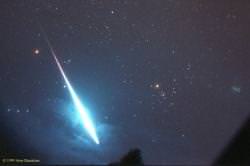While normally our friends in the Southern Hemisphere get left out of most major meteor showers, now is the time to keep alert for the Alpha Centaurids which are active during the entire month of February. While the Alpha Centaurids are considered a minor meteor shower, they do create some interesting viewing during the summer nights south of the equator. The peak (time of most activity) should occur around the universal date of Februrary 6/7, but don’t wait until then to start your observations!
According to the American Meteor Society:
“The Alpha Centaurids (ACE) are active from a radiant located at 13:44 (206) -58. This area of the sky is located in southeastern Centaurus, four degrees northwest of the brilliant star Hadar (beta Centauri). Current rates would be near one shower member per hour. These meteors are best seen near 0500 local standard time when the radiant lies highest above the horizon. This shower is not visible north of 32 degrees north latitude and also poorly seen in the northern tropics. The southern hemisphere offers a much better view of this activity as the radiant lies much higher in the southern sky. Those located at high southern latitudes will actually encounter morning twilight before the radiant reaches culmination. At 56 km/sec. the Alpha Centaurids will usually produce meteors of swift velocity.
Sporadic rates are now slowly falling no matter your location. One would expect to see approximately twelve random meteors during the last hour before dawn from rural observing sites in the northern hemisphere and fifteen from the southern hemisphere. During the first dark hour after the end of evening twilight, perhaps two random meteors can be seen per hour, no matter your location.”
While you’re out, take advantage of the opportunity to enjoy Centaurus! As one of the most inspiring constellations of the Southern Hemisphere, it also ranks as the ninth largest constellation and contains two of the ten brightest stars in the night sky – including the closest star to our own Sun. While the stargazers in the north rarely get an opportunity to explore the “Centaur”, nearly 2000 years ago precession allowed the ancient Greeks to observe the constellation during the spring. Even though they weren’t able to explore as we can today, they were still able to see Alpha and Beta Centauri, the third and tenth brightest stars in the sky. While many lists call Betelgeuse in Orion the tenth brightest star, remember… Betelgeuse is a variable!
Be sure to observe Alpha Centauri. One of the reasons it is so bright is not luminosity… but because it’s only 4.3 light years away. Rigel Kentaurius is a triple star system and a real beauty to binoculars and telescopes! Beta Centauri – Hadar – is a star on the move and in about 4000 years it will be close enough to Alpha to appear as a double star. While they won’t be gravitationally bound, a separation of 300 light years will make them a magnificent sight! Centaurus also contains Omega Centauri (NGC 5139), the largest and richest globular cluster in the sky. Centaurus also contains 20 open clusters and several galaxies including Centaurus A (NGC 5128), one of the brightest radio objects in the sky. While you’re there, be on the lookout because the a large portion of our own galaxy is also visible in Centaurus and there are over 100 easily visible stars.
Because you’re in for a moonless night and the days around the Centaurid Meteor shower peak will be of little moon-interference, this will be one of the best for Southern Hemsiphere SkyWatchers. If you live in the north? It never hurts to try. Even from my high latitude, I still get an occasional peek at some of Centaurus’ stars. Long noted for extremely bright meteors with persistent trails and flurries of high activity, I’m sure you’ll enjoy the incredible Centauri meteor shower!


meteor showers are truly inspirational in their own right. It is beautiful to look at how dynamic nature is even at grand scales!
I saw one of these this morning (2-4-2008), at about 5:30am MST, at my home in central New Mexico (Estancia). It was still dark when I went out to get my newspaper. As I bent over to pick it up, there was a flash of light, as if there had been lightning. I looked up, and in the east I saw a lovely turquoise green meteor slowly descend and then wink out. It isn’t often a meteor creates enough light to reflect off the ground.
the picture attached to the article is just crazy!
imagine something like that flares up infront of you!
blew my mind
chris
Im staying in malaysia, just above australia. can i see it too?
I SAW IT! at first i thought it was just a flash of light…I was walking back to the parking lot at school, February 6 2008, at about 9pm pst…I live in Cerritos, CA….It is awesome =D